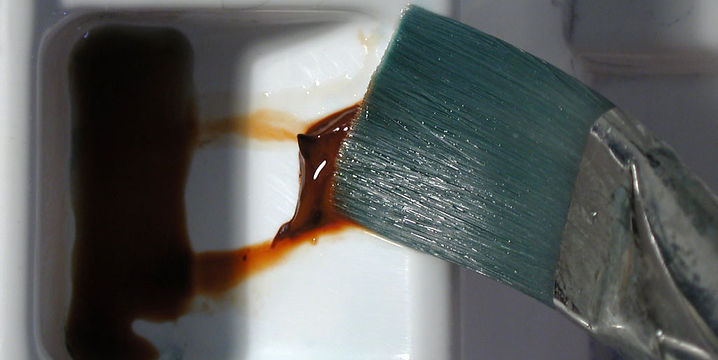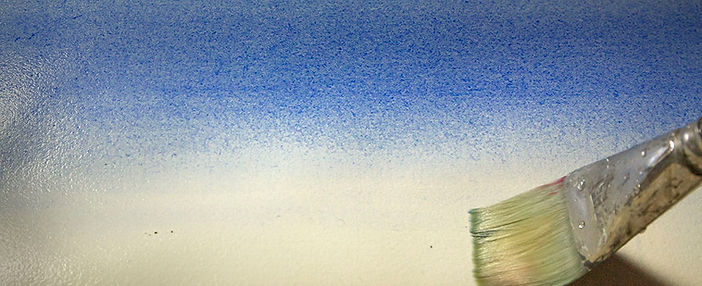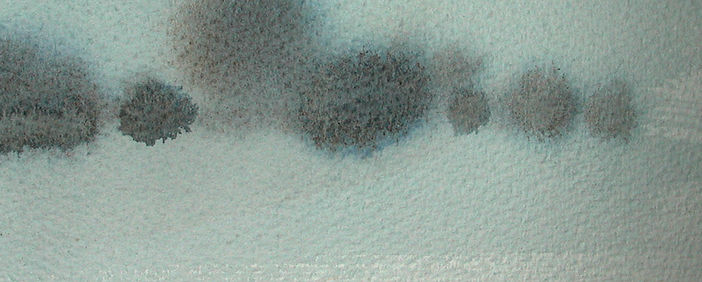
Mixing Colors and Applying Paint
In this section we will go right back to the basics and look at the steps involved in mixing colors and applying paint. From a few varied tubes of color to the infinite variety of tones and colors required to make a painting.
-
Squeezing out paint
-
Transferring paint from well to palette
-
Mixing Colors on the palette
-
Painting Water
-
Washes
-
Dropping in
-
Wet in wet
-
Softening edges
-
Dry brush
-
Splashing

Squeezing Out Paint
Fresh paint is best, so squeeze out what you think will be enough for the painting you are working on. Using a watercolor palette with sloping sides on the wells allows you to squeeze the paint out at the top of the slope. All the mud and debris caused by mixing and dipping runs into the bottom of the well, leaving your paint reasonably clean. This sludge that accumulates at the bottom of the wells can be used to mix all those interesting browns greys and earth colours you will often use.
Don’t be frugal with your paint, always have plenty in your palette. There is nothing more difficult and frustrating than trying to mix colors from tiny little specks of watercolor. Don’t worry if you squeeze out too much, it can always be used later. Even though fresh paint is nicer to use, dry watercolor and gouache paint can be dampened and reused years after it has been squeezed out.

Squeeze the watercolor paint onto the top of the slope in your palette well
Mixing Colors and Applying Paint – From Well to Palette
Always use a wet brush to transfer your paint from the well to the mixing area of the palette. If the paint has just been squeezed out your brush need only be damp. If the paint has dried out you will need a fair amount of water and quite a bit of friction to dissolve enough to mix strong colors.
If you have old left over paint on your palette it is a good idea to give it a light spray with water ten minutes before you start painting. This will soften the pigment and make mixing much easier.

Use a damp brush to move fresh paint from the well to the mixing area of your palette

Use a fairly wet brush to dissolve and move older, dry paint to the mixing area of your palette.
Mixing Colors on the Palette
Wetting an area on the palette before mixing helps the paint dissolve with out sticking to the palette. I usually transfer the first color to the mixing area and stir it around until it has completely and evenly dissolved. I then dip directly into what ever other color has to be added, then stir that in.
I rarely wash my brush out between colors, it only dilutes the mixture and tends to make the painting pale and insipid. During the course of a painting the colors become slightly contaminated with one another.
On the rare occasion when a pure unpolluted color is required, a wipe over with a clean damp brush usually exposes fresh paint.

Transfer paint from the well to the palette and stir until it is thoroughly dissolved.
This process of mixing watercolor usually requires much dipping and adjusting until the correct combination appears on the palette. The secret is to gradually add small amounts until you arrive at the correct color.
Be very cautious with strong staining colors like Phthalo Blue, Windsor Red, Prussian Blue etc. A big brush full of any of these will completely overpower any mixture.

For color intensity, mixing one color into another is best done without rinsing the brush between paint wells.
Once you are happy with the color, the tone or value of that colour can then be considered. The tone is simply the lightness or darkness of the color. With watercolor I always tend to mix a darker, more concentrated tone than I need.
Lightening the tone is done by adding a little water. This can be done on the palette, but I will often put a slightly darker mixture than required onto the paper then quickly spread it out with a clean, damp brush, adding water if necessary to adjust the tone.
Painting Water
Some people like to paint with crystal clear water and even keep a separate container to rinse out brushes. I find a container of moderately dirty water does just as good a job as clean water.
Water has to be pretty dirty to have a noticeable influence on the colors you mix. Since most of the time we are using compound colors (containing all three primaries) dirty water is not a problem.
If you are doing a watercolor wash of pure Permanent Rose or Aureolin for instance, then clean water is more important, but for general painting, if you can’t see the bottom it’s probably time to change it.
Mixing Colors and Applying Paint – Application Techniques
Color is transferred from the palette to the paper in different ways depending on the desired effect. The methods described below are some of the most commonly used techniques.
Washes
For a broad watercolor wash the paper is wet first with clean water, then a large pool of paint and water is mixed in a container or on the palette and evenly applied to the wet surface.
Tilting the painting surface and starting at the top with a horizontal line of pigment is the traditional way of applying a flat even wash. The bead of paint formed at the bottom of the first stroke is encouraged down the paper with subsequent horizontal strokes.

It is important not to leave any gaps as you work your way down the paper. If, for any reason, the wash looks a little uneven, don’t be tempted to go back and make adjustments – it will only create problems. As the wash dries it will tend to lighten and even itself out.

By progressively diluting the mixture with each stroke the wash can be evenly graded from color to white paper.
Dropping In
Colors are often adjusted or mixed directly on the paper. This is done by the process of dropping in. A color is applied to the painting and while it is still very wet another color is mixed on the palette and “dropped into” the first color. It is a great way to add some life to a dull, uninteresting area.

Dropping in color produces interesting variations and gradations that can’t be made by mixing the colors on the palette.
Wet In Wet
Similar to dropping in is the wet in wet technique. Here a wash is applied and while it is still very wet another color is painted into it. The resulting edges are soft and blurred. It is excellent for painting distant trees or mountains.

Wet in wet produces interesting soft edges and is a great technique for pushing things back into the distance.
Softening Edges
Similar in appearance to wet in wet are softened or feathered edges. This is a technique applied to the edge of any flat area of wet paint. Use a clean, damp brush and run it along the wet edge allowing the paint to bleed out into this damp area.

A single stroke with a damp brush is all that is needed to soften an edge.
Don't make the brush too wet or you will end up creating another hard edge further out.
Don't make the brush too dry or you will simply lift off pigment.
Dry Brush
Almost the opposite to wet in wet is the process known as dry brush. The technique is applied to dry paper with a damp brush loaded with pigment. The process is simple, color is mixed on the palette in the usual way then, before transferring the brush to the paper, excess moisture is removed. Wiping the brush lightly on an old towel is ideal for this.
The brush is held flat, almost parallel to the paper, and the paint is applied with the side of the bristles rather than the tip. This technique will produce a random, fractured mark, picking up the texture of the paper. It is a good technique for painting foliage or applying texture to your painting.

Dry brush gives interesting random shapes and textures.
Splashing
Splashing paint onto the paper will give you interesting random marks impossible to consciously apply. Your will need a big brush saturated with a fairly dilute mixture of the desired color.
The best way to apply the paint and maintain control is with a quick downward movement stopping suddenly without flicking. If you are nervous about splattering paint all over your painting, tear a suitable sized hole in a piece of scrap paper and place it on the painting, exposing only the area you wish to splatter.
Cafe
To keep this painting interesting, most of the techniques described here are employed in varying degrees. The soft marks under the figures and the Ultramarine Blue beside the bottom awning were painted wet in wet.
The shift in color in the awnings and in the green sign are the result of dropping in colors.
The underlying dirty yellow washes and the mauve patch under the upstairs window have all had their edges softened with a damp brush.
There are patches of dry brush in amongst the figures and in the striped green upstairs blind.

Most paintings incorporate a combination of these paint application techniques. A painting done completely wet in wet would look all soft and fluffy and need some hard edges to give it interest. A painting using only dry brush or hard edges would be busy and difficult to look at without the relief of a few soft edges.
In your next painting, keep in mind these techniques, and stop and think occasionally, “What is the best way to achieve the effect I am after?”
Author: John Lovett